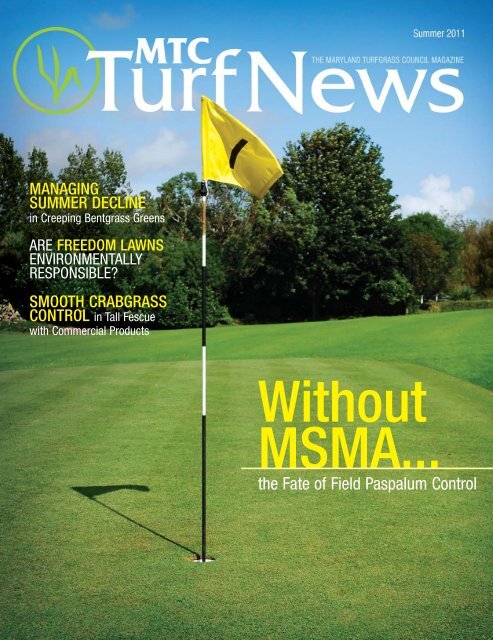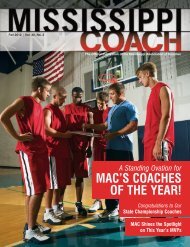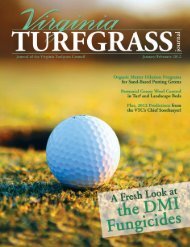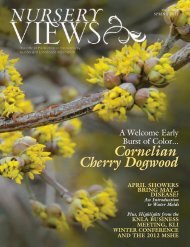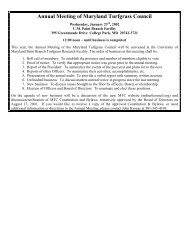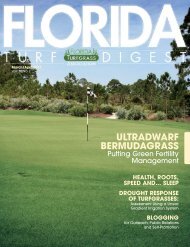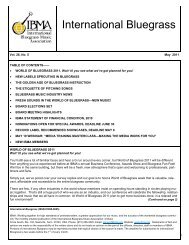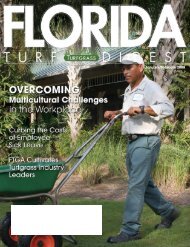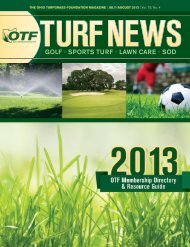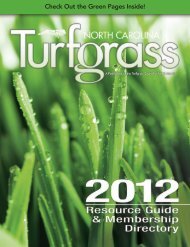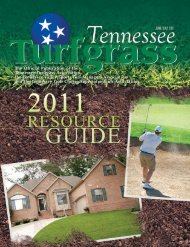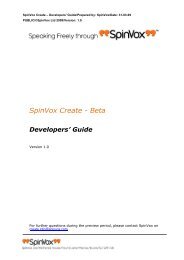the Fate of Field Paspalum Control - The Paginator
the Fate of Field Paspalum Control - The Paginator
the Fate of Field Paspalum Control - The Paginator
Create successful ePaper yourself
Turn your PDF publications into a flip-book with our unique Google optimized e-Paper software.
MANAGING<br />
SUMMER DECLINE<br />
in Creeping Bentgrass Greens<br />
ARE FREEDOM LAWNS<br />
ENVIRONMENTALLY<br />
RESPONSIBLE?<br />
SMOOTH CRABGRASS<br />
CONTROL in Tall Fescue<br />
with Commercial Products<br />
Without<br />
MSMA...<br />
<strong>the</strong> <strong>Fate</strong> <strong>of</strong> <strong>Field</strong> <strong>Paspalum</strong> <strong>Control</strong>
8<br />
16 22 26<br />
CONTENTS • Summer 2011<br />
08 TURF TALK<br />
Without MSMA… <strong>the</strong> <strong>Fate</strong><br />
<strong>of</strong> <strong>Field</strong> <strong>Paspalum</strong> <strong>Control</strong><br />
16 FEATURE STORY<br />
Are Freedom Lawns<br />
Environmentally Responsible?<br />
22 APPLIED RESEARCH<br />
Smooth Crabgrass <strong>Control</strong><br />
in Tall Fescue with<br />
Commercial Products<br />
26 GREEN LIGHT ON GOLF<br />
Managing Summer Decline<br />
in Creeping Bentgrass Greens<br />
DEPARTMENTS<br />
06 PRESIDENT’S MESSAGE<br />
25 MEMBERSHIP APPLICATION<br />
30 UNIVERSITY OF<br />
MD TURF TEAM<br />
30 CALENDAR OF EVENTS<br />
30 ADVERTISERS INDEX<br />
4 MTC TURF NEWS
MARYLAND<br />
TURFGRASS<br />
COUNCIL<br />
12 Pressie Lane | Churchville, MD 21028<br />
(240) 413-4312 | www.mdturfcouncil.org<br />
MTC Turf News is published<br />
quarterly for <strong>the</strong> MTC by:<br />
Leading Edge<br />
Communications, LLC<br />
206 Bridge St.<br />
Franklin, TN 37064<br />
615-790-3718 ( phone)<br />
615-794-4524 (fax)<br />
info@leadingedge<br />
communications.com<br />
2011 BOARD<br />
OF DIRECTORS<br />
PRESIDENT<br />
Vernon W. Cooper<br />
All States Turf Consultant<br />
St. Michaels, MD<br />
410-745-9643 (<strong>of</strong>fice)<br />
443-742-6618 (cell)<br />
vernon@allstatesturf.com<br />
VICE PRESIDENT<br />
Lester Dubs<br />
Pasadena, MD<br />
443-623-1745 (cell)<br />
ldubs@verizon.net<br />
SECRETARY/TREASURER<br />
Cheryl A. Gaultney<br />
Churchville, MD<br />
410-836-2876 (home)<br />
410-322-8275 (cell)<br />
sandqueen10@aol.com<br />
PAST PRESIDENT<br />
Nick Gammill<br />
American University<br />
W. Hyattsville, MD<br />
202-885-2340 (<strong>of</strong>fice)<br />
202-498-8020 (cell)<br />
ngammill@american.edu<br />
EXECUTIVE DIRECTOR<br />
Michelle LoConte<br />
Montgomery Village, MD<br />
301-990-0196 (<strong>of</strong>fice)<br />
240-597-1420 (fax)<br />
mdturfcouncil@verizon.net<br />
THREE YEAR<br />
DIRECTORS<br />
Harry Kenney<br />
Agrium Advanced<br />
Technologies<br />
Ellicott City, MD<br />
800-235-6138<br />
410-375-6148 (cell)<br />
hkenney@agriumat.com<br />
Bob Shumate<br />
Calvert Co. Parks & Rec.<br />
Prince Frederick, MD<br />
410-535-1600, ext 2225<br />
410-610-9007 (cell)<br />
shumatrr@co.cal.md.us<br />
Bill Warpinski<br />
Central Sod Farms<br />
Centreville, MD<br />
800-866-1387<br />
410-827-5000<br />
billw@centralsod.com<br />
TWO YEAR DIRECTORS<br />
Randall Pinckney<br />
Manor Country Club<br />
Rockville, MD<br />
301-929-1707<br />
240-286-1989 (cell)<br />
rpinckney@mail.manorcc.org<br />
Jamie Roell<br />
Anne Arundel Co.<br />
Rec. & Parks<br />
Millersville, MD<br />
410-222-6250<br />
443-370-2582 (cell)<br />
rproel09@aacounty.org<br />
OPEN<br />
ONE-YEAR DIRECTORS<br />
Rick LaNore<br />
MRW Lawns, Inc.<br />
LaPlata, MD<br />
301-870-3411 (<strong>of</strong>fice)<br />
301-609-1852 (cell)<br />
rick127928@rocketmail.com<br />
Bill Patton, Sr.<br />
Turf Center Lawns<br />
Spencerville, MD<br />
301-384-9300 (<strong>of</strong>fice)<br />
301-980-3094 (cell)<br />
turfcenterlawns@yahoo.com<br />
Kevin Monaco<br />
Turf Equip & Supply<br />
Jessup, MD 20794<br />
410-799-5575 (<strong>of</strong>fice)<br />
443-250-1182 (cell)<br />
kevinmonaco@turfequipment.com<br />
Patriot Bermuda from Buy Sod<br />
Tough. Aggressive. Fiercely Competitive.<br />
Chosen by NFL, collegiate and high school teams across <strong>the</strong> Mid-<br />
Atlantic and Midwest. Patriot Bermudagrass shrugs <strong>of</strong>f wear, tear and<br />
cold wea<strong>the</strong>r like no o<strong>the</strong>r sports turf. And Buy Sod, one <strong>of</strong> <strong>the</strong><br />
largest, most respected certified sod suppliers in <strong>the</strong> region has it —<br />
ready to install on your field now.<br />
Give your athletes <strong>the</strong> winning home-field advantage. Team up with<br />
Patriot Bermudagrass and Buy Sod.<br />
866-4BUYSOD<br />
www.BuySod.com<br />
Producing next generation grasses for a better environment.<br />
Bermudagrasses Available: Patriot, TifGrand, TifSport, T10, 419<br />
Zoysias: Zeon, JaMur, El Toro, Meyer, Empire, Emerald, Palisades<br />
Also: TifBlair Centipedegrass, Raleigh and Captiva St.<br />
Augustinegrass<br />
Buy Sod<br />
SUMMER 2011<br />
5
PRESIDENT’S MESSAGE<br />
WHAT A<br />
SPRING,<br />
and What We Accomplished!<br />
What a spring we have had!! Back in March, <strong>the</strong> owner <strong>of</strong> a lawncare<br />
company called me to ask, “What <strong>the</strong> heck is going on? Why am I<br />
having to treat dandelions way before I am even thinking <strong>of</strong> applying<br />
pre-emergent herbicides for summer annual grass control? This certainly is not<br />
a normal spring.”<br />
Hmmm… a “normal” spring. I am not sure I remember or even know what<br />
a normal spring is anymore. I have been working in turfgrass for 37 years and<br />
cannot remember two springs being <strong>the</strong> same. We have all chosen to live and<br />
work here in <strong>the</strong> center <strong>of</strong> <strong>the</strong> “transition zone” where our climate is not fit for<br />
any grass to grow without pr<strong>of</strong>essional help, which keeps us all in business. I<br />
still remember <strong>the</strong> first two sentences uttered at <strong>the</strong> beginning <strong>of</strong> my first turfgrass<br />
class at <strong>the</strong> University <strong>of</strong> Maryland many years ago. Dr. Jack Hall started<br />
<strong>the</strong> class by saying, “If you can pr<strong>of</strong>essionally manage turfgrass in Maryland for<br />
five years and keep your job, you can work anywhere in <strong>the</strong> United States.” He<br />
also commented, “<strong>The</strong> best grass in Maryland is green concrete.” Thank goodness<br />
we have such a dedicated group <strong>of</strong> pr<strong>of</strong>essionals who are determined to<br />
make turfgrass not only survive but flourish.<br />
Not only are we constantly battling Mo<strong>the</strong>r Nature, but we <strong>of</strong>ten have to<br />
battle <strong>the</strong> knuckleheads in Annapolis and <strong>the</strong> federal EPA — both think turfgrass<br />
is <strong>the</strong> root <strong>of</strong> all evil and is <strong>the</strong> cause for <strong>the</strong> ruination <strong>of</strong> <strong>the</strong> Chesapeake Bay.<br />
I am not convinced <strong>the</strong>y all think turfgrass is this ultimate polluter. I think some<br />
are just lazy and think turfgrass is an easy target because it is made up <strong>of</strong> a<br />
bunch <strong>of</strong> little companies running around competing with each o<strong>the</strong>r. Little did<br />
<strong>the</strong>y know that <strong>the</strong>se little companies have a big umbrella watching over <strong>the</strong>m,<br />
and that umbrella is called <strong>the</strong> MTC.<br />
This legislative year, Delegates Hubbard, Babe and Clagett and Delegates<br />
Braveboy, Frush, Penna-Melnyk, Wood and Glenn decided to sponsor <strong>The</strong> Fertilizer<br />
Use Act (HB 573). This was part <strong>of</strong> <strong>the</strong> answer to <strong>the</strong> EPA to show that<br />
Maryland was making strides to meet <strong>the</strong> EPA’s arbitrary standards for nitrogen<br />
and phosphorus loads entering <strong>the</strong> Chesapeake Bay. I say arbitrary because<br />
nei<strong>the</strong>r <strong>the</strong> EPA’s standards nor <strong>the</strong> proposed Maryland legislation were based<br />
upon sound scientific bases but instead were being driven mostly by politics.<br />
Fortunately, organizations like RISE and <strong>the</strong> MTC follow legislation that will<br />
affect any <strong>of</strong> our members. A special thanks must go out to Mark Schlossberg<br />
(a former MTC president), Rick LaNore (also a former MTC president and a<br />
current board member) and o<strong>the</strong>rs<br />
who spent hours and days testifying<br />
before legislative committees, meeting<br />
with individual state Senators and<br />
Delegates, sending emails to keep us<br />
all informed and leading letter-writing,<br />
email and phone campaigns, all in<br />
order to develop legislation with<br />
some semblance <strong>of</strong> common sense.<br />
<strong>The</strong> essence <strong>of</strong> this legislation is<br />
probably best explained by Mark<br />
Schlossberg, president <strong>of</strong> Pro-Lawn-<br />
Plus, Inc./M.A.G.I. (MD Assoc. <strong>of</strong><br />
Green Industries, Inc.), in an email<br />
after <strong>the</strong> last session <strong>of</strong> <strong>the</strong> General<br />
Assembly on April 11, 2011:<br />
<strong>The</strong> Fertilizer Use Act was passed<br />
tonight in <strong>the</strong> Maryland General<br />
Assembly on <strong>the</strong> final day <strong>of</strong> <strong>the</strong><br />
session as HB 573. Though this<br />
bill will cost our industry some<br />
money and change <strong>the</strong> way we do<br />
business somewhat, I feel like <strong>the</strong><br />
adjustments we have to make will<br />
not jeopardize our businesses and<br />
golf courses. And <strong>the</strong> fact that we<br />
now will have fertilizer pre-emption<br />
means that we won’t have to worry<br />
about local jurisdictions making<br />
<strong>the</strong>ir own fertilizer laws. We were<br />
able to get <strong>the</strong> final date for fall<br />
N and P applications extended to<br />
December 1st. We’ll still be able<br />
to apply K and limestone between<br />
6 MTC TURF NEWS
December 1st and March 1st. We<br />
were able to get allowances for<br />
controlled-release nitrogen at higher<br />
rates and an exemption for organic<br />
fertilizer P applications. From<br />
my understanding <strong>of</strong> <strong>the</strong> bills, <strong>the</strong><br />
certification/training portion will<br />
take effect in October 2012, and<br />
<strong>the</strong> date restrictions will not take<br />
place until <strong>the</strong> fall <strong>of</strong> 2013.<br />
I will get more clarification and<br />
details from <strong>the</strong> Department over<br />
<strong>the</strong> next few weeks, and I’m sure<br />
this will be discussed in <strong>the</strong> training<br />
sessions UMD puts on in <strong>the</strong><br />
fall and winter.<br />
One final note: one <strong>of</strong> <strong>the</strong> reasons<br />
we supported this legislation was that<br />
we as an industry wanted to get <strong>the</strong><br />
message out to some <strong>of</strong> our allies —<br />
like <strong>the</strong> farm community, soil-conservation<br />
people and <strong>the</strong> general public<br />
— that we are willing to do our part.<br />
We might not feel that <strong>the</strong> changes<br />
required in <strong>the</strong> bill will help <strong>the</strong> Bay.<br />
Now, though, we will be able to say<br />
that we are willing to contribute to<br />
<strong>the</strong> reduction <strong>of</strong> N and P output.<br />
I want to thank everyone who came<br />
to Annapolis for meetings, called and<br />
emailed legislators, acquiesced on<br />
issues that <strong>the</strong>y really didn’t want to,<br />
etc. I feel our support <strong>of</strong> this legislation<br />
will help us immensely in <strong>the</strong> future<br />
when <strong>the</strong>re are bills introduced that<br />
we oppose.<br />
I guess time will tell.<br />
Fortunately, <strong>the</strong> enforcement <strong>of</strong> this<br />
legislation will be <strong>the</strong> Department <strong>of</strong><br />
Agriculture, which with <strong>the</strong> University<br />
<strong>of</strong> Maryland must develop a training<br />
and certification program for<br />
“certified applicators.”<br />
<strong>The</strong> MTC will work with <strong>the</strong><br />
Department <strong>of</strong> Agriculture to develop<br />
and present as much information as<br />
possible at our January Turfgrass<br />
Conference. Stand by — more is<br />
to come!<br />
Vernon W. Cooper<br />
MTC President<br />
SUMMER 2011<br />
7
TURF TALK<br />
By Peter H. Dernoeden, Ph.D., and Christopher P. Ryan, Dept. <strong>of</strong> Plant Science and Landscape Architecture, University <strong>of</strong> Maryland<br />
ield or smooth paspalum<br />
(<strong>Paspalum</strong> laeve Michx.) is an<br />
increasing weed problem in<br />
turfgrass sites in Maryland. <strong>Field</strong><br />
paspalum is a warm-season perennial<br />
that has a bunch-type growth habit,<br />
but plants may develop one or two<br />
short (1.5 to 2.0 cm) rhizomes. Vernation<br />
is folded, and foliage is typically<br />
grayish green or yellow green. Leaves<br />
and sheaths are hairy and have a short<br />
(1.0 to 2.0 mm) membranous ligule.<br />
<strong>Paspalum</strong> rapidly spreads by<br />
seed. Seedheads appear in late summer<br />
(usually September), and spikelets are<br />
formed opposite on <strong>the</strong> inflorescence.<br />
Seeds are distinctly disk shaped (i.e.,<br />
round, with flat sides).<br />
This species <strong>of</strong>ten is confused with<br />
dallisgrass (P. dilatatum Poir.), which<br />
is not as commonly found as field<br />
paspalum as far north as Maryland.<br />
<strong>The</strong> distribution <strong>of</strong> dallisgrass in<br />
Maryland has not been assessed in<br />
recent years, but it is believed to<br />
be now more commonplace than<br />
previously reported.<br />
<strong>The</strong> new control problem<br />
Since <strong>the</strong> 1960s, monosodium and<br />
disodium methanearsonates (MSMA<br />
and DSMA) have been used on turf to<br />
control field paspalum, dallisgrass<br />
and crabgrass (Digitaria spp.). MSMA<br />
and DSMA are organic forms <strong>of</strong><br />
arsenic that are relatively non-toxic<br />
and are considered less toxic than<br />
aspirin. (Inorganic forms <strong>of</strong> arsenic,<br />
like calcium arsenate, are highly toxic<br />
and were banned from use on turf<br />
several decades ago.)<br />
DSMA was withdrawn from <strong>the</strong><br />
market several years ago. On December<br />
31, 2010, <strong>the</strong> EPA cancelled registration<br />
<strong>of</strong> MSMA use for residential,<br />
commercial and sports turf maintenance.<br />
Existing stocks <strong>of</strong> MSMA,<br />
however, may be used legally on residential,<br />
commercial and sports fields<br />
until December 31, 2013. Sale <strong>of</strong> all<br />
products containing MSMA for use<br />
on golf courses, sod farms and highway<br />
right-<strong>of</strong>-ways will end on December<br />
31, 2012, and use <strong>of</strong> existing<br />
8 MTC TURF NEWS
stocks on golf courses after December<br />
31, 2013, will be prohibited. <strong>The</strong> EPA<br />
also has restricted <strong>the</strong> use <strong>of</strong> MSMA<br />
to spot applications, and o<strong>the</strong>r restrictions<br />
apply (U.S. EPA, 2009).<br />
MSMA and DSMA were <strong>the</strong> only<br />
known effective and selective herbicides<br />
for use on many cool-season<br />
grasses for control <strong>of</strong> dallisgrass, field<br />
paspalum and o<strong>the</strong>r <strong>Paspalum</strong> spp.<br />
Hence, new herbicides need to be<br />
identified for controlling <strong>the</strong>se turfinvading<br />
<strong>Paspalum</strong> spp.<br />
Our research<br />
<strong>The</strong> search for alternative herbicides<br />
for control <strong>of</strong> field paspalum began<br />
at <strong>the</strong> University <strong>of</strong> Maryland Paint<br />
Branch Turfgrass Research Facility<br />
in College Park in 2009. We conducted<br />
three separate field studies in<br />
2009 and 2010. In 2009, we assessed<br />
Fusilade II T&O (fluazifop-P), Segment<br />
(sethoxydim) and Round-up<br />
(gylphosate) in an unimproved site <strong>of</strong><br />
perennial ryegrass and Kentucky bluegrass.<br />
In 2010, we evaluated Fusilade<br />
II, Velocity (bispyribac-sodium),<br />
Dismiss (sulfentrazone) and Certainty<br />
(sulfosulfuron) in a mature stand <strong>of</strong><br />
tall fescue (Festuca arundinacea).<br />
Also in 2010, we assessed Tenacity<br />
(mesotrione) and Tupersan (siduron)<br />
as preemergence treatments in springseeded<br />
stands <strong>of</strong> tall fescue, hard<br />
fescue (F. brevipilia) and perennial<br />
ryegrass (Lolium perenne).<br />
In both 2010 studies, <strong>the</strong> herbicide<br />
treatments were applied for purposes<br />
o<strong>the</strong>r than targeting field paspalum.<br />
Once some level <strong>of</strong> field paspalum<br />
control became evident in <strong>the</strong> 2010<br />
sites, however, data were collected<br />
despite paspalum not being <strong>the</strong><br />
main target.<br />
Herbicides were applied in 50 gallons<br />
<strong>of</strong> water per acre using a CO2<br />
powered (35 psi) backpack sprayer<br />
Photo 1. <strong>Field</strong> paspalum is a warm-season perennial bunchgrass.<br />
Photo 2. <strong>Field</strong> paspalum on a bentgrass tee.<br />
Summary <strong>of</strong> Key Findings<br />
• Fusilade II appears to be an alternative<br />
to MSMA for postemergence<br />
control <strong>of</strong> field paspalum<br />
in tall fescue turf.<br />
• Fusilade II also is known to be<br />
safe to use in hard fescue, but<br />
more research needs to confirm<br />
if o<strong>the</strong>r turfgrass species are<br />
tolerant <strong>of</strong> <strong>the</strong> herbicide.<br />
• More research is needed to identify<br />
effective Fusilade II label use<br />
rates and timings. <strong>The</strong> Fusilade II<br />
label would have to be amended<br />
to include <strong>Paspalum</strong> spp.<br />
• Postemergence applications <strong>of</strong><br />
Certainty, Dismiss and Velocity<br />
alone were ineffective in controlling<br />
field paspalum, but a tank<br />
mix <strong>of</strong> Velocity + Dismiss showed<br />
some promise.<br />
• Preemergence applications <strong>of</strong><br />
Tenacity and Tupersan to spring<br />
seedbeds provided significant<br />
reductions <strong>of</strong> field paspalum<br />
development from seed, but<br />
many plants did escape.<br />
• Certainty was extremely phototoxic<br />
to tall fescue and is labeled<br />
for selective tall fescue control<br />
in Kentucky bluegrass turf.<br />
SUMMER 2011<br />
9
TURF TALK • continued<br />
equipped with an 8004E flat fan nozzle.<br />
Fusilade II and Tenacity were tankmixed<br />
with 0.25% v/v <strong>of</strong> Activator 90<br />
non-ionic surfactant (NIS) in 2009 and<br />
2010. Rates and dates <strong>of</strong> application<br />
are noted below.<br />
<strong>Field</strong> paspalum cover was assessed<br />
visually using a 0% to 100% scale,<br />
where 0 = no paspalum and 100 =<br />
entire plot area covered by paspalum.<br />
In <strong>the</strong> 2010 postemergence study, <strong>the</strong><br />
number <strong>of</strong> field paspalum plants in<br />
each plot also were counted. In <strong>the</strong><br />
2010 postemergence study, turf quality<br />
was visually assessed using a 0 to<br />
10 scale, where 0 = entire plot area<br />
brown/dead and 10 = optimum green<br />
color and turf density. Tall fescue<br />
injury was assessed once in 2010 using<br />
a 0 to 5 scale, where 0 = no injury,<br />
2.5 = objectionable and unacceptable<br />
injury and 5 = entire plot was<br />
brown/dead.<br />
Photo 3. Grayish-green field paspalum in a tall fescue lawn.<br />
Table 1. Postemergence control <strong>of</strong> field paspalum in an unimproved site in<br />
College Park, MD, 2009.<br />
Cover<br />
Rate % field paspalum % turf<br />
Treatment* (lb. ai/A) Aug. 3 Aug. 28<br />
Segment 1L 0.47 6 b** 27 a<br />
Fusilade II T & O 2L 0.375 0 c 48 a<br />
Tenacity 4SC + Fusilade II<br />
0.187<br />
+ 0.375<br />
0 c 67 a<br />
Round-up 3L 0.18 15 b 42 a<br />
Untreated – 78 a 37 a<br />
** All herbicides were applied on June 10, 2009.<br />
** Means in a column followed by <strong>the</strong> same letter are not significantly different according to<br />
Fisher’s protected LSD, P = 0.05.<br />
Our 2009 results<br />
On June 10, Fusilade II (0.375 lb.<br />
ai/acre), Segment (0.47 lb. ai/A),<br />
Tenacity (0.187 lb. ai/A) + Fusilade II<br />
(0.375 lb. ai/A) and Round-up (8.0 oz.<br />
product/A) were applied to a dense<br />
stand <strong>of</strong> field paspalum growing in<br />
a low-maintenance situation. <strong>Field</strong><br />
paspalum cover was assessed on<br />
August 3 (43 days after <strong>the</strong> herbicides<br />
were applied). At that time, no field<br />
paspalum (i.e., 100% control) was<br />
observed in plots treated with Fusilade<br />
II and Tenacity + Fusilade II. Both<br />
Segment (6% cover = 92% control)<br />
and Roundup (15% cover = 81%<br />
control) had reduced field — paspalum<br />
populations compared to <strong>the</strong> control<br />
(78% paspalum cover) (see Table 1).<br />
Turfgrass cover was estimated<br />
on August 28. Turf cover was low<br />
throughout <strong>the</strong> site due to a lack <strong>of</strong><br />
care and <strong>the</strong> high population <strong>of</strong> field<br />
paspalum. <strong>The</strong>re were no significant<br />
turf cover differences among herbicidetreated<br />
plots. It is likely that <strong>the</strong> relatively<br />
dense field paspalum canopy<br />
at <strong>the</strong> time <strong>of</strong> application intercepted<br />
most <strong>of</strong> <strong>the</strong> herbicide applied and thus<br />
may account for <strong>the</strong> similarity in turf<br />
cover percentages among herbicide<br />
and non-herbicide-treated plots.<br />
Our 2010 results<br />
In <strong>the</strong> 2010 postemergence study,<br />
Velocity (0.033 and 0.066 lb. ai/A),<br />
Dismiss (0.125 lb. ai/A) and Velocity<br />
+ Dismiss (0.033 + 0.125 lb. ai/A)<br />
were applied three times (on May<br />
10 MTC TURF NEWS
continued • TURF TALK<br />
27, June 11 and June 23); Certainty<br />
(0.023 lb. ai/A) was applied twice on<br />
(May 27 and June 11); and Fusilade<br />
II (0.375 lb. ai/A) was applied once<br />
(on May 27).<br />
According to plant count data,<br />
Dismiss and <strong>the</strong> high rate <strong>of</strong> Velocity<br />
reduced <strong>the</strong> number <strong>of</strong> field paspalum<br />
plants per plot compared to <strong>the</strong> control,<br />
but <strong>the</strong> low rate <strong>of</strong> Velocity had<br />
no effect (Table 2). <strong>The</strong> most effective<br />
treatments were Fusilade II and Velocity<br />
+ Dismiss, both <strong>of</strong> which reduced<br />
<strong>the</strong> field paspalum population 84%<br />
compared to <strong>the</strong> control. When plots<br />
were evaluated by estimating field<br />
paspalum cover ra<strong>the</strong>r than plant<br />
counts, only Fusilade II had reduced<br />
weed cover compared to <strong>the</strong> control.<br />
<strong>The</strong> low rate <strong>of</strong> Velocity (0.033<br />
lb./A) applied three times reduced tall<br />
Photo 4. <strong>Field</strong> paspalum in unmown hard fescue.<br />
Table 2. Tall fescue quality and injury, and field paspalum control as influenced by herbicides in College Park, MD, 2010.<br />
Treatment<br />
Rate<br />
(lb. ai/A)<br />
No.<br />
Applic.*<br />
June<br />
10<br />
June<br />
23<br />
Turf quality (0 – 10)<br />
July<br />
6<br />
July<br />
12<br />
Aug.<br />
5<br />
Sept.<br />
9<br />
Injury<br />
(0 – 5)<br />
July<br />
6<br />
plants/<br />
plot<br />
Sept. 9<br />
<strong>Paspalum</strong><br />
%<br />
cover<br />
Velocity 17.6SG<br />
0.033 3 8.0 a** 7.6 a 5.6 c 6.0 ab 7.0 a 6.8 b 2.8 c 55.3 ab 14.0 ab<br />
Velocity 17.6SG<br />
0.066 3 7.0 bc 6.1 c 4.1 d 4.8 c 5.4 b 6.6 b 3.8 b 29.5 bcd 9.0 bc<br />
Dismiss 4F<br />
0.125 3 7.5 ab 7.3 a 6.9 ab 6.3 ab 7.0 a 7.1 b 1.1 de 27.8 cd 9.0 bc<br />
Velocity + Dismiss<br />
0.033 +<br />
0.125<br />
3 7.5 ab 7.2 ab 5.6 c 5.7 bc 7.0 a 7.0 b 2.8 c 11.3 d 4.3 bc<br />
Certainty 75DG<br />
0.023 2 6.4 c 4.6 d 1.0 e 1.3 d 1.5 c 2.0 c 4.9 a 57.2 abc 20.5 a<br />
Fusilade II T&O 2L<br />
0.375 1 5.6 d 6.3 bc 6.5 b 6.0 ab 7.3 a 8.0 a 2.0 cd 11.0 d 1.8 c<br />
Untreated — — 8.0 a 8.0 a 7.5 a 6.8 a 6.9 a 6.7 b 0.8 e 68.5 a 12.0 ab<br />
**Treatments were applied 3 times on May 27, June 11 and June 23; twice on May 27 and June 11; and once on May 27, 2010.<br />
**Means in a column followed by <strong>the</strong> same letter are not significantly different according to Fisher’s LSD, P ≤ 0.05.<br />
SUMMER 2011<br />
11
TURF TALK • continued<br />
fescue quality on July 6, but <strong>the</strong> high<br />
rate <strong>of</strong> Velocity (0.066 lb. ai/A)<br />
reduced quality from June 23 until<br />
data collection ended on September<br />
Photo 5. <strong>Field</strong> paspalum spreads readily by seed.<br />
9 (Table 2). <strong>The</strong> single application <strong>of</strong><br />
Fusilade II reduced tall fescue quality<br />
from June 10 to July 12. Certainty was<br />
applied twice and almost completely<br />
eliminated <strong>the</strong> tall fescue, while Dismiss<br />
(applied three times) did not<br />
injure <strong>the</strong> tall fescue. Certainty is<br />
labeled for <strong>the</strong> purpose <strong>of</strong> selectively<br />
controlling tall fescue in Kentucky<br />
bluegrass. Thus, death <strong>of</strong> most <strong>of</strong><br />
<strong>the</strong> tall fescue plants in Certaintytreated<br />
plots came as no surprise.<br />
In <strong>the</strong> preemergence 2010 study, <strong>the</strong><br />
site was first treated with Round-up<br />
(glyphosate) on April 5, and <strong>the</strong>n<br />
separate blocks were disk-seeded with<br />
tall fescue, perennial ryegrass and<br />
hard fescue on April 6. Tenacity was<br />
applied once at 0.50 lb. ai/A on April<br />
12 or twice at 0.125, 0.156, 0.187<br />
and 0.25 lb. ai/A on April 12 and May<br />
12 (mixed with 0.25% v/v NIS on<br />
May 12 only). Tupersan was applied<br />
once at 12 lb. ai/A or twice at 6.0 lb.<br />
ai/A on April 12 and May 12.<br />
Data were collected on September 9,<br />
and all treatments generally provided<br />
a statistically equivalent level <strong>of</strong><br />
field paspalum control (Table 3).<br />
For Tenacity-treated tall fescue and<br />
Table 3. <strong>Field</strong> paspalum cover in three spring-seeded turfgrass species in College Park, MD, 2010.<br />
Rate % field paspalum cover on Sept. 9, 2010<br />
Herbicide* (lb. ai/A) TF PRG HF<br />
Tenacity 4SC 0.50 11 b** 16 b 50 b<br />
Tenacity 4SC 0.125 + 0.125 11 b 18 b 48 b<br />
Tenacity 4SC 0.156 + 0.156 6 b 17 b 45 bc<br />
Tenacity 4SC 0.187 + 0.187 8 b 16 b 26 bcd<br />
Tenacity 4SC 0.25 + 0.25 2 b 10 b 22 cd<br />
Tupersan 50WP 12.0
Fusilade II may be<br />
a viable alternative<br />
to MSMA for postemergence<br />
control<br />
<strong>of</strong> field paspalum in<br />
tall fescue, but it<br />
has limitations.<br />
perennial ryegrass plots, control ranged<br />
from 73% to 94%, and 91% to 98%<br />
control in <strong>the</strong> Tupersan-treated plots.<br />
<strong>The</strong> hard fescue developed more<br />
slowly and thus was more heavily<br />
colonized by field paspalum. In hard<br />
fescue, field paspalum cover ranged<br />
from 22% to 50% in Tenacitytreated<br />
plots, whereas only 5% field<br />
paspalum cover (94% control) was<br />
observed in Tupersan-treated hard<br />
fescue. This may be <strong>the</strong> first report<br />
<strong>of</strong> preemergence control <strong>of</strong> field<br />
paspalum at spring seeding in coolseason<br />
turf with any herbicide.<br />
Conclusions<br />
Fusilade II may be a viable alternative<br />
to MSMA for postemergence control<br />
<strong>of</strong> field paspalum in tall fescue, but<br />
it has limitations. Interestingly, Dr.<br />
Jim Brosnsan (at <strong>The</strong> University <strong>of</strong><br />
Tennessee) reported in 2010 that<br />
Fusilade II applied just one time in<br />
early spring at 0.09 lb. ai/A (5.6 fl. oz.<br />
product/A) provided 90% dallisgrass<br />
control. Conversely, when Fusilade<br />
II was applied in early summer, <strong>the</strong><br />
level <strong>of</strong> dallisgrass control was poor.<br />
<strong>The</strong> Fusilade II label is somewhat<br />
vague on how to use this herbicide.<br />
<strong>The</strong> label simply states that Fusliade<br />
II is to be used for <strong>the</strong> suppression<br />
and/or control <strong>of</strong> common bermudagrass,<br />
hybrid bermudagrass and o<strong>the</strong>r<br />
grass weeds in zoysiagrass and tall<br />
fescue. It is not for use on home lawns.<br />
<strong>The</strong>re is no mention <strong>of</strong> any paspalum<br />
species being a target weed on <strong>the</strong><br />
SUMMER 2011<br />
13
TURF TALK • continued<br />
It is important to note that <strong>the</strong> effectiveness <strong>of</strong> Tenacity and<br />
Tupersan in controlling field paspalum preemergence from<br />
seed in mature turfgrass stands is unknown.<br />
Fusilade II label. <strong>The</strong> label also states<br />
that <strong>the</strong> application rate for Fusilade<br />
II to tall fescue “should be” 5 to 6 oz.<br />
product/A. <strong>The</strong> label fur<strong>the</strong>r states<br />
that tall fescue may be injured but<br />
should recover in 10 to 14 days.<br />
In <strong>the</strong>se studies, Fusilade II was<br />
applied at 24 oz. product/A (i.e., 0.375<br />
lb. ai/A), which is four times <strong>the</strong> high<br />
label use rate for tall fescue. No injury<br />
was noted in <strong>the</strong> unimproved site<br />
(mostly Kentucky bluegrass and perennial<br />
ryegrass) with Fusilade II and<br />
o<strong>the</strong>r herbicides. This was attributed<br />
to <strong>the</strong> tall, dense field paspalum canopy,<br />
which likely intercepted most <strong>of</strong><br />
<strong>the</strong> herbicide before it could reach<br />
<strong>the</strong> underlying turf. It was observed,<br />
however, that this very high rate <strong>of</strong><br />
Fusilade II injured tall fescue in <strong>the</strong><br />
2010 study for a period <strong>of</strong> about 35<br />
to 40 days, but <strong>the</strong> turf eventually<br />
recovered. <strong>The</strong> injury took <strong>the</strong> form <strong>of</strong><br />
browning and stunting <strong>of</strong> leaves, as<br />
well as some thinning <strong>of</strong> <strong>the</strong> tall fescue<br />
stand. In unrelated UM studies, it was<br />
found that hard fescue showed no<br />
signs <strong>of</strong> injury from <strong>the</strong> same high<br />
Fusilade II rate used in this study.<br />
Results from <strong>the</strong> 2010 study also<br />
suggest that <strong>the</strong> mix <strong>of</strong> Velocity +<br />
Dismiss is ano<strong>the</strong>r candidate for future<br />
study. This mix also reduced tall fescue<br />
quality for about 30 days. Hence,<br />
future research needs to focus on<br />
lower use rates and perhaps more<br />
frequent applications <strong>of</strong> <strong>the</strong>se herbicides<br />
to maximize <strong>the</strong>ir effectiveness<br />
while minimizing injury to tall fescue.<br />
Ano<strong>the</strong>r key finding was that<br />
Tenacity and Tupersan reduced field<br />
paspalum populations significantly<br />
when applied preemergence to springseeded<br />
stands <strong>of</strong> tall fescue, perennial<br />
ryegrass and hard fescue. Many field<br />
paspalum seedlings, however, escaped<br />
and were problematic in <strong>the</strong> springseeded<br />
stands. <strong>The</strong> level <strong>of</strong> control<br />
was poorest in hard fescue. This was<br />
attributed to <strong>the</strong> slower development<br />
<strong>of</strong> hard fescue, which did not compete<br />
as effectively with field paspalum as<br />
did <strong>the</strong> more rapidly developing tall<br />
fescue and perennial ryegrass seedlings.<br />
Numerically, lowest field<br />
paspalum cover ratings were observed<br />
in Tupersan-treated plots. Regardless,<br />
it would be helpful to use ei<strong>the</strong>r<br />
Tupersan or Tenacity in <strong>the</strong> seedbed<br />
when renovating turfs that were previously<br />
contaminated by field paspalum.<br />
It is important to note that <strong>the</strong><br />
effectiveness <strong>of</strong> Tenacity and Tupersan<br />
in controlling field paspalum preemergence<br />
from seed in mature turfgrass<br />
stands is unknown. In unrelated<br />
UM studies, however, it is been well<br />
established that Tenacity and Tupersan<br />
generally perform poorly in controlling<br />
crabgrass (Digitaria spp) preemergence<br />
in mature turf stands, and thus, it is<br />
likely that this would be also true <strong>of</strong><br />
field paspalum. •<br />
14 MTC TURF NEWS
APPLIED RESEARCH<br />
16 MTC TURF NEWS
Are<br />
Freedom Lawns<br />
Environmentally Responsible?<br />
By Erik Ervin, Ph.D., Associate Pr<strong>of</strong>essor <strong>of</strong> Turfgrass Culture & Physiology, Crop and<br />
Soil Environmental Sciences Department, Virginia Tech<br />
Many Mid-Atlantic residents live<br />
within <strong>the</strong> Chesapeake Bay<br />
Watershed and have a home<br />
lawn. Many are also aware that Bay<br />
health remains impaired due to excess<br />
nitrogen (N) and phosphorus (P) and<br />
sediment loading from <strong>the</strong> daily activities<br />
required in our densely populated<br />
society. <strong>The</strong>se pollutants come from<br />
many sources, including sewage-treatment<br />
plants, city streets, development<br />
sites, agricultural operations and deposition<br />
from <strong>the</strong> air.<br />
Do nutrient pollutants come from<br />
home lawns? Lawn fertilizer contains<br />
N and P, so it is easy to jump to <strong>the</strong><br />
conclusion that <strong>the</strong>y do. Many who<br />
value <strong>the</strong> environmental and economic<br />
health <strong>of</strong> <strong>the</strong> Bay have come to this<br />
conclusion, leading <strong>the</strong>m to advocate<br />
something called <strong>the</strong> Freedom Lawn.<br />
What is a Freedom Lawn? <strong>The</strong><br />
basic concept is to take any existing<br />
lawn and continue only one cultural<br />
practice: periodic mowing. All o<strong>the</strong>r<br />
practices are to be discontinued: no<br />
fertilizer, no pesticides and no irrigation.<br />
<strong>The</strong> homeowner is <strong>the</strong>n free to<br />
pursue o<strong>the</strong>r interests, free from <strong>the</strong><br />
added costs <strong>of</strong> <strong>the</strong>se inputs and free<br />
to proclaim to interested neighbors<br />
that he or she is protecting <strong>the</strong> water<br />
quality <strong>of</strong> <strong>the</strong> Chesapeake Bay. But is<br />
that so? In what follows, I discuss and<br />
present data on how <strong>the</strong> Freedom<br />
Lawn choice may actually result in<br />
more potential for degraded Bay<br />
water quality.<br />
Let’s review <strong>the</strong> research<br />
What happens when all inputs, except<br />
periodic mowing, are removed from<br />
lawns? All around us, we see <strong>the</strong><br />
results in our parks, lawns and school<br />
grounds: weeds and open soil areas<br />
increase. Ignoring <strong>the</strong> aes<strong>the</strong>tic drawbacks,<br />
what are <strong>the</strong> potential waterquality<br />
impacts? A recently published<br />
study at <strong>the</strong> University <strong>of</strong> Minnesota<br />
provides some answers.<br />
<strong>The</strong> researchers installed Kentucky<br />
bluegrass sod on a silt loam soil with<br />
a 5% slope to easily allow run<strong>of</strong>f<br />
collection. To simulate soil compaction<br />
resulting from home-building activities,<br />
<strong>the</strong> compaction caused by <strong>the</strong> bulldozer<br />
during laser-leveling was not<br />
relieved by tillage prior to sodding.<br />
No fertilizer was applied during <strong>the</strong><br />
first year. In <strong>the</strong> second year, <strong>the</strong> following<br />
treatments were applied to<br />
various plots in this study and continued<br />
over years three through five:<br />
• No fertilizer<br />
• Standard N (3 lbs./1,000 ft 2 /yr) +<br />
no P + standard potassium (K)<br />
• Standard N (3 lbs./1,000 ft 2 /yr) +<br />
1x P (as recommended by soil test)<br />
+ standard K<br />
• Standard N (3 lbs./1,000 ft 2 /yr) +<br />
3x P (as recommended by soil test)<br />
+ standard K<br />
SUMMER 2011<br />
17
APPLIED RESEARCH • continued<br />
Fertilizer treatments were applied in<br />
1/3 equal increments in May, September<br />
and October <strong>of</strong> each year, based<br />
on standard lawn fertilization guidelines<br />
from Minnesota Cooperative<br />
Extension. <strong>The</strong>se guidelines closely<br />
match those <strong>of</strong> Virginia Cooperative<br />
Extension. No irrigation was used on<br />
<strong>the</strong>se lawn plots. <strong>The</strong> initial soil test<br />
P level was 25 ppm; this level is in <strong>the</strong><br />
sufficiency range, so <strong>the</strong> testing lab<br />
recommended little to no P for normal<br />
lawn maintenance.<br />
What happened? By year three, <strong>the</strong><br />
no-fertilizer plots had greatly reduced<br />
turf density, greater weed density, more<br />
exposed soil and more dead grass/weed<br />
tissue than <strong>the</strong> N fertilized plots.<br />
Adding P at a 1x or 3x rate did not<br />
improve turf density relative to applying<br />
N-alone. Significantly, total P<br />
run<strong>of</strong>f from <strong>the</strong> no-fertilizer plots was<br />
greatest over <strong>the</strong> three years <strong>of</strong> monitoring<br />
because <strong>of</strong> greater run<strong>of</strong>f depth.<br />
That is, more water was lost from <strong>the</strong><br />
plots that did not receive N fertilizer<br />
because <strong>of</strong> insufficient turf cover to<br />
impede flow, especially when <strong>the</strong> soil<br />
surface was frozen. Contained within<br />
this run<strong>of</strong>f water was also a greater<br />
load <strong>of</strong> P bound to soil and leaflitter<br />
sediment.<br />
Thus, as long as enough N was<br />
applied to maintain density and retard<br />
weed invasion, less P was lost in run<strong>of</strong>f,<br />
relative to <strong>the</strong> no-fertilizer control,<br />
even when P was applied at 3 times <strong>the</strong><br />
recommended rate. I do not make this<br />
point to justify over-application <strong>of</strong> P<br />
to lawns, but merely to highlight that<br />
<strong>the</strong> controlling factor in reducing P<br />
run<strong>of</strong>f from lawns is turf density.<br />
Researchers in New York (a Chesapeake<br />
Bay state) have reported similar<br />
results. <strong>The</strong>y established an 80%<br />
Kentucky bluegrass/20% perennial<br />
ryegrass area from seed on a sandy<br />
loam soil with an 8% slope, using<br />
various natural organic and syn<strong>the</strong>tic<br />
fertilizer treatments. Once <strong>the</strong> plots<br />
were mature (year 2,) results showed<br />
that <strong>the</strong> unfertilized control plots had<br />
significantly higher P-mass losses compared<br />
to any <strong>of</strong> <strong>the</strong> fertilized plots.<br />
<strong>The</strong>se losses strongly correlated with<br />
less shoot density and lower infiltration<br />
rates on <strong>the</strong> unfertilized control plots.<br />
A direct quote is that “as shoot density<br />
doubled, <strong>the</strong> infiltration rate increased,<br />
which reduced run<strong>of</strong>f by three-fold.”<br />
<strong>The</strong> highest annual rate <strong>of</strong> fertilizer<br />
N applied in this study was moderate,<br />
at 2 lbs./1,000 ft 2 , but it was enough<br />
to ensure adequate turf density and<br />
water infiltration. Nitrate-N run<strong>of</strong>f<br />
from <strong>the</strong> organic or syn<strong>the</strong>tic fertilizer<br />
treatments did not differ from<br />
<strong>the</strong> unfertilized control, averaging<br />
between 2 to 4.5 ppm, considerably<br />
18 MTC TURF NEWS
continued • APPLIED RESEARCH<br />
below <strong>the</strong> EPA limit for safe drinking<br />
water (10 ppm).<br />
Interpreting <strong>the</strong> research<br />
Given <strong>the</strong>se data, what does a Freedom<br />
Lawn <strong>of</strong>fer for water quality in<br />
<strong>the</strong> Chesapeake Bay Watershed? <strong>The</strong><br />
unfertilized control plots in <strong>the</strong> studies<br />
above received only periodic mowing<br />
(fitting <strong>the</strong> definition <strong>of</strong> a Freedom<br />
Lawn), and it took only two or<br />
three years for <strong>the</strong> “Freedom plots”<br />
to become greater contributors <strong>of</strong> P<br />
loading via run<strong>of</strong>f than <strong>the</strong> areas moderately<br />
fertilized with nitrogen.<br />
Eleanor Roosevelt is credited with<br />
saying that “with freedom comes<br />
responsibility.” In my analysis, Freedom<br />
Lawns do not embrace <strong>the</strong>ir<br />
environmental responsibility and,<br />
in fact, can fairly rapidly become<br />
irresponsible. A more responsible<br />
approach heeds <strong>the</strong> scientific data,<br />
recognizes <strong>the</strong> limitations imposed by<br />
urban soil disturbance during development<br />
and recommends that we<br />
strive for “Sustainable Lawns” by<br />
following a set <strong>of</strong> best management<br />
practices (BMPs), with <strong>the</strong> goal <strong>of</strong><br />
maintaining lawn surfaces with minimized<br />
water-quality impacts.<br />
BMPs for Sustainable Lawns<br />
Below are 12 BMPs for Sustainable<br />
Lawns throughout <strong>the</strong> Chesapeake<br />
Bay Watershed.<br />
BMP#1: Improve <strong>the</strong> soil at<br />
establishment to reduce compaction<br />
and improve infiltration.<br />
In new-housing construction, much <strong>of</strong><br />
<strong>the</strong> topsoil is removed, and <strong>the</strong> remaining<br />
subsoil is severely compacted.<br />
Replacing a shallow topsoil layer prior<br />
to grassing is helpful in getting <strong>the</strong><br />
lawn established, but <strong>the</strong> underlying<br />
soil compaction remains. Subsequently,<br />
long term, water infiltration is poor,<br />
greatly increasing <strong>the</strong> possibility <strong>of</strong><br />
thin turf and <strong>of</strong>f-site movement<br />
<strong>of</strong> nutrients.<br />
Thus, prior to topsoil placement,<br />
<strong>the</strong> subsoil should be cleared <strong>of</strong> all<br />
debris and rip-plowed and tilled.<br />
Topsoil can <strong>the</strong>n be distributed and<br />
a seedbed prepared. Adding a 1" to<br />
2" layer <strong>of</strong> quality compost prior to<br />
seedbed preparation would also be<br />
very beneficial to lawn health and<br />
water infiltration over time.<br />
BMP#2: Plant or re-plant best-adapted<br />
turfgrass species and varieties.<br />
Each year, <strong>the</strong> turfgrass programs at<br />
Virginia Tech and <strong>the</strong> University <strong>of</strong><br />
Maryland collaborate to put out a list<br />
<strong>of</strong> recommended turf varieties, based<br />
on field evaluations (found here:<br />
http://www.pubs.ext.vt.edu/3008/30<br />
08-1456/3008-1456.html). To make<br />
<strong>the</strong> list, each variety must have performed<br />
above average at both test<br />
sites for at least three years. Each<br />
listed variety must also be available as<br />
certified seed, ensuring genetic purity<br />
and seed quality to <strong>the</strong> buyer. With<br />
adequate establishment, odds are that<br />
<strong>the</strong>se varieties will provide greater<br />
stress persistence than those not on<br />
<strong>the</strong> list.<br />
BMP#3: Improve <strong>the</strong> soil after<br />
establishment to reduce compaction<br />
and improve infiltration.<br />
Most homeowners inherit a lawn with<br />
compacted soil. Core aeration and<br />
compost topdressing can slowly correct<br />
compaction. <strong>The</strong> rolling-drum aerators<br />
commonly used or rented, however,<br />
pull up cores from only 1% to 3%<br />
<strong>of</strong> <strong>the</strong> lawn surface area and do not<br />
go much deeper than 2".<br />
To improve water infiltration and<br />
relieve compaction, go over <strong>the</strong> lawn<br />
in two to four directions during moist<br />
(not wet) soil conditions, twice a year<br />
during periods <strong>of</strong> active turfgrass<br />
growth. If possible, hand-spread and<br />
rake in a quality compost applied at<br />
100 lbs./1,000 ft 2 . <strong>The</strong> average size <strong>of</strong><br />
home lawns across Virginia is 5,000<br />
ft 2 , requiring 500 lbs. <strong>of</strong> compost for<br />
each application.<br />
Repeatedly applying organic matter<br />
via <strong>the</strong> compost will build topsoil, bind<br />
nutrients and water and promote soil<br />
aggregation for improved water infiltration<br />
and compaction resistance.<br />
Fur<strong>the</strong>r, it will serve as a natural<br />
organic slow-release fertilizer, providing<br />
approximately 1.5 lbs. N/1,000<br />
ft 2 each time it is applied. Two compost<br />
applications per year would,<br />
<strong>the</strong>n, provide all <strong>the</strong> fertility <strong>the</strong> lawn<br />
requires to remain healthy and dense<br />
enough to greatly limit any potential<br />
P or N run<strong>of</strong>f.<br />
BMP#4: Soil test every 1 to 3 years<br />
to determine if fertilizer P is needed;<br />
use fertilizers with 0% P (e.g., 30-0-<br />
10) if <strong>the</strong> soil test indicates no need.<br />
Binding readily to clay minerals and<br />
soil organic matter, phosphorus does<br />
not leach. Thus, soil-test P levels<br />
change quite slowly in most Virginia<br />
soils. With our moderate rainfall, soil<br />
pH does fall, but not fast enough to<br />
require re-liming more frequently than<br />
every two to three years. Soil testing<br />
every one to three years, <strong>the</strong>refore, is<br />
adequate to ensure sufficient P availability.<br />
If <strong>the</strong> soil test indicates no P<br />
need, <strong>the</strong>n select fertilizers that contain<br />
no P.<br />
BMP#5: Implement a moderate<br />
fertilizer N program based on Virginia<br />
Cooperative Extension and Virginia<br />
Department <strong>of</strong> Conservation and<br />
Recreation recommendations.<br />
Our research review (above) clearly<br />
indicated that not applying N-containing<br />
fertilizer is not a responsible choice<br />
for pollution prevention. A moderate<br />
amount <strong>of</strong> N per year (1 to 4 lbs.<br />
actual N/1,000 ft 2 ) is needed to maintain<br />
enough turf cover to impede sediment-bound<br />
P loss. Refer to <strong>the</strong>se<br />
online sources to guide your N fertilization<br />
practices: http://www.pubs.<br />
ext.vt.edu/452/452-717/452-717.html<br />
and http://www.dcr.virginia.gov/soil<br />
and water/documents/tipsstate.pdf.<br />
High-use lawns will need N at <strong>the</strong><br />
3- to 4-lb. level to push enough growth<br />
to ensure adequate cover against<br />
run<strong>of</strong>f. Adequate cover on low-use<br />
lawns can be maintained via 1- or 2-<br />
lb. programs.<br />
For added insurance against N<br />
run<strong>of</strong>f or leaching losses, use fertilizers<br />
with higher proportions <strong>of</strong> slow- or<br />
SUMMER 2011<br />
19
APPLIED RESEARCH • continued<br />
controlled-release N sources. Using<br />
slow-release sources, including organics,<br />
also reduces surge growth, reducing<br />
mowing requirements relative to<br />
using quick-release N sources.<br />
BMP#6: Do not apply fertilizers to<br />
frozen soils.<br />
Several studies have noted that 60% to<br />
90% <strong>of</strong> P-run<strong>of</strong>f occurs during winter<br />
thawing periods when <strong>the</strong> surface soil<br />
is still frozen. Such large run<strong>of</strong>f events<br />
occur because <strong>the</strong> soils are ei<strong>the</strong>r frozen<br />
or saturated, prohibiting water<br />
infiltration and allowing soil- or leaflitter-bound<br />
P present in open soil<br />
areas to be quickly lost. Applying P-<br />
containing fertilizers too late (November<br />
or December) or too early (February<br />
or March) greatly increases <strong>the</strong><br />
potential <strong>of</strong> P loading into Bay waters.<br />
BMP#7: Do not apply fertilizer to<br />
impervious surfaces; immediately<br />
sweep or blow any granules back<br />
onto <strong>the</strong> lawn.<br />
Fertilizer, compost, grass clippings and<br />
tree leaves all contain nutrients. As<br />
such, it is irresponsible to leave any<br />
<strong>of</strong> <strong>the</strong>m on impervious surfaces<br />
where <strong>the</strong>y can move unimpeded<br />
into storm drains.<br />
BMP#8: Mow high, and follow <strong>the</strong><br />
1/3 rule.<br />
This BMP is all about maintaining<br />
density and high biomass on your<br />
lawn: both factors increase water-flow<br />
resistance, slowing run<strong>of</strong>f and increasing<br />
infiltration. Mowing turf at <strong>the</strong><br />
higher end <strong>of</strong> recommended ranges<br />
(3" – 4" for bluegrass and fescue; 1.5"<br />
– 2.5" for bermudagrass and zoysiagrass)<br />
will accomplish this, while also<br />
providing a deeper-rooted, more stresstolerant<br />
lawn.<br />
Mowing high also means you can<br />
mow less frequently without breaking<br />
<strong>the</strong> 1/3 rule. <strong>The</strong> 1/3 rule is to never<br />
remove more than 33% (1/3) <strong>of</strong> <strong>the</strong><br />
grass height at one mowing. Repeatedly<br />
removing too much at each mowing<br />
(e.g., mowing a 5" lawn down to<br />
2" = 60% removal) results in a shallow<br />
root system that produces turf<br />
thinning and weed invasion. For fescue<br />
lawns, not breaking <strong>the</strong> 1/3 rule means<br />
mowing back to a 3" height each<br />
time <strong>the</strong> lawn reaches 4.5".<br />
BMP#9: Leave clippings on <strong>the</strong><br />
lawn, removing any that reach<br />
impervious surfaces.<br />
Grass clippings contain 2% to 5% N<br />
and about 0.5% P, and <strong>the</strong>y break<br />
down quickly, re-releasing <strong>the</strong>se nutrients<br />
for root uptake. Clipping return<br />
can serve as an organic fertilizer, providing<br />
more than 1 lb. N/1,000 ft 2 /yr.<br />
Left on <strong>the</strong> street, however, <strong>the</strong>se<br />
nutrients can quickly move into storm<br />
drains to pollute <strong>the</strong> Bay. If large clipping<br />
clumps accumulate, ei<strong>the</strong>r rake<br />
<strong>the</strong>m up and compost <strong>the</strong>m on-site,<br />
or mow <strong>the</strong> lawn in 2-3 directions to<br />
disperse <strong>the</strong>m.<br />
BMP#10: Mulch tree leaves into<br />
<strong>the</strong> lawn and clean up any that<br />
accumulate on impervious surfaces.<br />
Studies at Michigan State, Purdue and<br />
Cornell have documented that mulching<br />
a 2" to 5" layer <strong>of</strong> deciduous tree<br />
leaves onto cool-season lawns for three<br />
to five consecutive autumns had no<br />
significant effects on lawn health or<br />
vigor. <strong>The</strong>se studies also reported no<br />
increases in thatch or undue reduction<br />
in soil pH due to this practice.<br />
Recycling tree leaves back into your<br />
lawn is safer for <strong>the</strong> environment than<br />
piling <strong>the</strong>m on <strong>the</strong> street and risking<br />
<strong>the</strong> loss <strong>of</strong> N and P to stormwater run<strong>of</strong>f.<br />
Mowing when <strong>the</strong> leaves are dry<br />
mulches <strong>the</strong>m much more effectively.<br />
BMP#11: Irrigate only if severe<br />
drought persists and threatens to<br />
significantly reduce turf cover.<br />
Adherence to <strong>the</strong> first 10 BMPs should<br />
result in a fairly deep-rooted lawn that<br />
should recover from summer droughts<br />
<strong>of</strong> two to three weeks. Droughts <strong>of</strong><br />
more than four weeks could result in<br />
<strong>the</strong> loss <strong>of</strong> some turf cover, especially<br />
if <strong>the</strong>re is any traffic on <strong>the</strong> lawn during<br />
drought-dormancy. In this case,<br />
lawn cover should be preserved by<br />
applying 0.75" to 1" <strong>of</strong> water per<br />
week until rainfall returns.<br />
BMP#12: Use pesticides only<br />
when weed, insect or disease levels<br />
threaten to significantly thin <strong>the</strong> lawn;<br />
strictly follow label directions.<br />
Careful application <strong>of</strong> <strong>the</strong> preceding<br />
BMPs to ensure a dense, healthy lawn<br />
should greatly minimize <strong>the</strong> need<br />
for pesticides.<br />
For homeowners who wish to have<br />
lawns that are environmentally friendly<br />
or more sustainable than what current<br />
suburban development gives <strong>the</strong>m,<br />
<strong>the</strong>re are two primary choices: take<br />
what you are given and improve it<br />
by following <strong>the</strong>se 12 BMPs, or start<br />
over by improving <strong>the</strong> soil and establishing<br />
a no-mow prairie and herbaceous/woody<br />
perennial landscape.<br />
Simply stopping all management<br />
inputs and calling it a “Freedom<br />
Lawn” is easy and cheap, but it may<br />
ultimately be irresponsible. •<br />
20 MTC TURF NEWS
APPLIED RESEARCH<br />
<strong>Control</strong>ling Smooth<br />
Crabgrass in Tall Fescue<br />
with Pre- and Postemergence Commercial Products<br />
By Peter H. Dernoeden, Ph.D., and C. P. Ryan, Dept. <strong>of</strong> Plant Science and Landscape Architecture, University <strong>of</strong> Maryland<br />
This field study, which was<br />
conducted at <strong>the</strong> University <strong>of</strong><br />
Maryland Paint Branch Turfgrass<br />
Research Facility in College<br />
Park, compared all <strong>of</strong> <strong>the</strong> commonly<br />
used preemergence herbicides that<br />
target smooth crabgrass (Digitaria<br />
ischaemum). In addition, corn gluten<br />
meal (Espoma Corn Gluten 9-0-0)<br />
was assessed and compared to <strong>the</strong><br />
commercial products. Finally, three<br />
postemergence herbicides were applied<br />
in late June and compared to <strong>the</strong> preemergence<br />
herbicides and corn gluten<br />
meal (CGM).<br />
Our research methods<br />
<strong>The</strong> turf was a mature stand <strong>of</strong> Titan<br />
II tall fescue (Festuca arundinacea)<br />
and was mowed two times weekly<br />
to a height <strong>of</strong> 2.5 inches. Soil was a<br />
Keyport silt loam with a pH <strong>of</strong> 5.7<br />
and 2.2% organic matter.<br />
Rates and dates <strong>of</strong> product applications<br />
are noted in Table 1. <strong>The</strong> site<br />
received rainfall or irrigation within<br />
24 hours <strong>of</strong> each application. <strong>The</strong><br />
study site was irrigated <strong>the</strong>reafter to<br />
avoid drought stress.<br />
Turf color and quality were rated<br />
once on May 13 using a 0 to 10 scale,<br />
where 0 = entire plot area brown or<br />
dead, and 10 = optimum green color<br />
and density. Percent <strong>of</strong> <strong>the</strong> plot areas<br />
covered with smooth crabgrass was<br />
assessed visually on a 0% to 100%<br />
scale, where 0% = no crabgrass, and<br />
100% = entire plot area covered with<br />
smooth crabgrass. Crabgrass ratings<br />
less than 5% <strong>of</strong> plot area covered<br />
(subjectively) were considered to have<br />
provided commercially acceptable control.<br />
Smooth crabgrass pressure was<br />
uniform and severe across <strong>the</strong> site.<br />
About CGM<br />
Corn gluten meal, <strong>the</strong> protein fraction<br />
<strong>of</strong> corn, is a natural herbicide that is<br />
used to control crabgrass and o<strong>the</strong>r<br />
weeds in “organic lawncare programs.”<br />
Corn gluten was evaluated<br />
previously by <strong>the</strong> University <strong>of</strong> Maryland<br />
(Dernoeden, 2001). In those<br />
studies, CGM applied twice per season<br />
reduced crabgrass populations significantly,<br />
but it did not provide commercially<br />
acceptable control. Single applications<br />
<strong>of</strong> CGM typically provided<br />
poor control.<br />
<strong>The</strong> product contains 9% to 10%<br />
nitrogen (N) and, as such, also serves<br />
as an N fertilizer. <strong>The</strong> recommended<br />
use rate <strong>of</strong> CGM is 20 lbs. product<br />
per 1,000 ft 2 . Hence, at this rate, a<br />
manager is delivering 1.8 to 2.0 lbs.<br />
N/1,000 ft 2 with a single application.<br />
A single spring application <strong>of</strong> 2.0 lbs.<br />
N/1,000 ft 2 , however, is considered<br />
agronomically excessive and wasteful.<br />
<strong>The</strong> sewage sludge Oceangro 5-5-0<br />
fertilizer was entered into <strong>the</strong> study to<br />
determine if this high rate <strong>of</strong> N (i.e.,<br />
2.0 lbs. N/1,000 ft 2 ) from a natural<br />
organic fertilizer would impact crabgrass<br />
levels at <strong>the</strong> site. That is, <strong>the</strong><br />
Oceangro served as a standard for<br />
comparing <strong>the</strong> potential influence <strong>of</strong><br />
organic N on crabgrass invasiveness in<br />
<strong>the</strong> study site. <strong>The</strong> levels <strong>of</strong> N delivered<br />
via CGM and Oceangro resulted in<br />
excellent turf color and quality (8.8<br />
22 MTC TURF NEWS
to 9.4) on May 13 (Table 1). Echelon<br />
0.3G + Fertilizer (about 0.65 lb.<br />
N/1,000 ft 2 ) improved color and<br />
quality compared to all o<strong>the</strong>r treatments,<br />
except CGM or Oceangro.<br />
Our research results<br />
Due to unusually high temperatures in<br />
late March and early April, crabgrass<br />
seedlings were observed on April 7,<br />
2010, which was about 8 to 12 days<br />
earlier than <strong>the</strong> usual emergence time.<br />
Most germination, however, occurred<br />
in June, but some new germination<br />
continued to be stimulated by thunderstorms<br />
in July and August. Since <strong>the</strong><br />
site was not allowed to enter a state<br />
<strong>of</strong> drought dormancy, crabgrass populations<br />
were kept in abeyance by <strong>the</strong><br />
presence <strong>of</strong> a fairly dense and competitive<br />
turf.<br />
Smooth crabgrass cover was<br />
assessed on July 12 and August 13.<br />
In general, crabgrass populations as<br />
low as 0.5% (i.e., one half <strong>of</strong> one<br />
percent <strong>of</strong> <strong>the</strong> plot area) in early July<br />
invariably indicate that <strong>the</strong> level <strong>of</strong><br />
crabgrass control will be unacceptable<br />
by early August (i.e., ≥120 days since<br />
<strong>the</strong> treatment was initially applied).<br />
Only data collected on August 13 will<br />
be discussed, but you can make your<br />
own judgment <strong>of</strong> each herbicide’s loss<br />
<strong>of</strong> residual effectiveness (i.e., through<br />
dissipation) based on <strong>the</strong> July 12<br />
evaluation. Crabgrass cover (i.e.,<br />
tillering) increases exponentially in late<br />
summer in College Park, MD, and<br />
mid-August ratings are more likely to<br />
identify significant treatment differences.<br />
By early September, however,<br />
even a single multi-tillered plant can<br />
cover 5% <strong>of</strong> <strong>the</strong> plot area, which is<br />
above <strong>the</strong> threshold.<br />
Crabgrass pressure was considered<br />
to be severe compared to most commercial<br />
lawn or golf course rough<br />
situations. All treatments, including<br />
Oceangro, reduced crabgrass levels<br />
significantly compared to <strong>the</strong> untreated<br />
control (Table 1). However, <strong>the</strong><br />
Table 1. Pre- and postemergence smooth crabgrass control with commercial herbicides, College Park, MD, 2010.<br />
Quality<br />
Color<br />
% Crabgrass Cover<br />
Herbicide*<br />
Rate (lb. ai/A)<br />
Timing<br />
May 13<br />
May 13<br />
July 12<br />
Aug. 13<br />
Dimension 2 EW<br />
0.38<br />
Pre<br />
6.8 c***<br />
6.6 e<br />
0.3 c<br />
4.8 d<br />
Dimension 0.21G<br />
0.38<br />
Pre<br />
6.9 c<br />
7.3 d<br />
0.5 c<br />
5.3 d<br />
Echelon 4SC<br />
0.75<br />
Pre<br />
6.9 c<br />
7.4 d<br />
0.0 c<br />
5.5 d<br />
Echelon 0.3G + Fert<br />
0.75<br />
Pre<br />
8.1 b<br />
8.4 c<br />
0.0 c<br />
1.3 d<br />
Barricade 4F<br />
0.75<br />
Pre<br />
6.9 c<br />
7.1 de<br />
0.0 c<br />
0.3 d<br />
Pendulum Aquacap 3.8ME<br />
1.5 + 1.5<br />
Pre<br />
6.6 c<br />
7.1 de<br />
0.0 c<br />
0.6 d<br />
Pendulum Aquacap 3.8ME<br />
3.0<br />
Pre<br />
6.8 c<br />
6.9 de<br />
0.1 c<br />
5.0 d<br />
Team Pro 2G (1992 product)<br />
3.0<br />
Pre<br />
6.8 c<br />
7.1 de<br />
0.0 c<br />
0.9 d<br />
Tenacity 4SC<br />
0.187 + 0.187<br />
Pre<br />
6.5 c<br />
6.9 de<br />
4.9 bc<br />
37.8 b<br />
Corn Glutten<br />
20 lbs./M<br />
Pre<br />
9.4 a<br />
9.4 a<br />
2.6 bc<br />
24.5 bc<br />
Corn Glutten<br />
15 + 15 lbs./M<br />
Pre<br />
9.3 a<br />
9.1 ab<br />
7.0 b<br />
26.5 b<br />
Oceangro 5-5-0<br />
2.0 lbs. N/M<br />
Pre<br />
9.3 a<br />
8.8 bc<br />
7.5 b<br />
39.3 b<br />
**Drive XLRB 1.5SC + MSO<br />
0.75<br />
Post<br />
7.3 bc<br />
6.9 de<br />
0.1 c<br />
9.8 cd<br />
**Acclaim Extra 0.57EW<br />
0.110<br />
Post<br />
7.1 c<br />
7.4 d<br />
0.0 c<br />
5.0 d<br />
**Tenacity 4SC + Activator<br />
0.187 + 0.187<br />
Post<br />
7.4 bc<br />
7.1 de<br />
0.0 c<br />
0.6 d<br />
Untreated<br />
—<br />
—<br />
7.1 c<br />
7.0 de<br />
12.8 a<br />
63.5 a<br />
*** Preemergence (Pre) treatments were applied April 2, and sequential treatments were applied May 18, 2010.<br />
*** Postemergence (Post) treatments were applied June 29 (2 to 4 tiller crabgrass); <strong>the</strong> Tenacity sequential treatment was applied July 13, 2010.<br />
*** Means in a column followed by <strong>the</strong> same letter are not significantly different according to Fisher’s LSD, P ≤ 0.05.<br />
SUMMER 2011<br />
23
APPLIED RESEARCH • continued<br />
crabgrass populations in plots treated<br />
with CGM, Oceangro and Tenacity<br />
applied as preemergents was excessive<br />
and ranged from 24% to 39% <strong>of</strong> plot<br />
area infested.<br />
All o<strong>the</strong>r treatments provided a<br />
statistically equivalent level <strong>of</strong> crabgrass<br />
control, and most products had<br />
provided commercially acceptable<br />
control (i.e., less than 5.0% crabgrass<br />
cover). This included Team Pro, which<br />
was a product that was received in<br />
1992 and stored dry in an open-bag<br />
condition for 18 years.<br />
<strong>The</strong> single postemergence application<br />
<strong>of</strong> Drive XLR8 on June 29 was<br />
judged to have provided unacceptable<br />
control, but data were statistically<br />
equivalent to <strong>the</strong> level <strong>of</strong> control provided<br />
by Acclaim Extra and Tenacity.<br />
Good control was provided by<br />
Dimension (both formulations) and<br />
Echelon (both formulations). Exceptional<br />
crabgrass control (i.e., less than<br />
1.0 crabgrass cover; > 98% control)<br />
was provided by Barricade, Pendulum<br />
AquaCap (1.5 + 1.5 lbs./A) and Team<br />
Pro applied preemergence, and by<br />
Tenacity applied twice postemergence<br />
(June 20 and July 13). •<br />
24 MTC TURF NEWS
MTC Membership Application<br />
____________________________________________________________________<br />
Name<br />
Title<br />
____________________________________________________________________<br />
Address<br />
____________________________________________________________________<br />
City, State, Zip Code<br />
E-Mail Address<br />
____________________________________________________________________<br />
Company Affiliation<br />
____________________________________________________________________<br />
Company Address<br />
____________________________________________________________________<br />
Company City, State, Zip Code<br />
____________________________________________________________________<br />
Business Fax<br />
Business Phone<br />
____________________________________________________________________<br />
Cell Phone<br />
Member <strong>of</strong>:<br />
[ ] ESGCS [ ] MAGCS [ ] MSA [ ] MSTA<br />
[ ] MTA [ ] PGMS [ ] OTHER __________________________________<br />
I wish to also apply for membership for <strong>the</strong><br />
following pr<strong>of</strong>essional members <strong>of</strong> my crew,<br />
utilizing <strong>the</strong> company address listed above:<br />
_____________________________________<br />
_____________________________________<br />
_____________________________________<br />
_____________________________________<br />
Please list additional names on a separate<br />
sheet & attach to this form or feel free to<br />
copy this form if you desire individuals to<br />
utilize <strong>the</strong>ir home addresses.<br />
ENCLOSED ARE:<br />
_______ MTC Membership Dues<br />
$15.00 per person $ __________<br />
_______ Donation to Turfgrass<br />
Survey $ _____________________<br />
_______ Donation to Turfgrass<br />
Endowment Fund $ ___________<br />
(tax deductible)<br />
Total Enclosed $ ______________________<br />
Please make checks payable to: MTC or<br />
MARYLAND TURFGRASS COUNCIL<br />
SUMMER 2011<br />
25
GREEN LIGHT ON GOLF<br />
Managing Summer<br />
Decline<br />
in a Creeping<br />
Bentgrass Green<br />
By Peter H. Dernoeden, Ph.D., and C. P. Ryan, Dept. <strong>of</strong> Plant Science and Landscape Architecture, University <strong>of</strong> Maryland<br />
Previous studies have documented<br />
improved summer performance<br />
<strong>of</strong> creeping bentgrass (Agrostis<br />
stolonifera) putting greens treated with<br />
selected fungicides even in <strong>the</strong> absence<br />
<strong>of</strong> disease. Chipco Signature, especially<br />
when tank-mixed with ei<strong>the</strong>r Daconil<br />
or Fore Rainshield, has been associated<br />
with color enhancement and<br />
improved cover and quality. Mancozeb<br />
was shown to mitigate scalping in<br />
“puffy” putting green turf in summer<br />
(Dernoeden and Fu, 2008). O<strong>the</strong>r<br />
studies have demonstrated <strong>the</strong> superior<br />
ability <strong>of</strong> spoonfeeding with urea to<br />
improve summer quality <strong>of</strong> putting<br />
greens, when compared to biostimulants,<br />
chelated iron and micronutrient<br />
products (Settle and Dernoeden, 2009).<br />
<strong>The</strong> non-disease-related benefits<br />
provided by some fungicides and urea<br />
are said to reduce summer decline.<br />
Summer decline <strong>of</strong> creeping bentgrass<br />
greens normally occurs in response<br />
to high-temperature stress combined<br />
with mechanical injury and sometimes<br />
diseases. Additional information<br />
regarding summer decline management<br />
with o<strong>the</strong>r products is warranted.<br />
<strong>The</strong> objective <strong>of</strong> this study was to<br />
assess various fungicides, as well as<br />
Super Stimulant (organic peat humates;<br />
6% humic acid) and Nano Argentum<br />
(elemental silver in osmotized water<br />
applied at 41 ml/acre), applied alone<br />
and/or tank-mixed with ano<strong>the</strong>r compound,<br />
for <strong>the</strong>ir ability to improve <strong>the</strong><br />
summer quality <strong>of</strong> a creeping bentgrass<br />
putting green turf. Urea was applied in<br />
a spoonfeeding program and served<br />
as <strong>the</strong> standard for comparison.<br />
Our research methods<br />
This field study at <strong>the</strong> University<br />
<strong>of</strong> Maryland Paint Branch Turfgrass<br />
Research Facility in College Park<br />
was conducted on an 80/20 sand/<br />
sphagnum peat moss (v/v) creeping<br />
bentgrass putting green constructed to<br />
USGA specifications. <strong>The</strong> area was a<br />
mature stand <strong>of</strong> ‘Declaration’ creeping<br />
bentgrass. <strong>The</strong> study area was fertilized<br />
with 2.5 lbs. N/1,000 ft 2 from mostly<br />
20-20-20 between September 20 and<br />
November 11, 2009. <strong>The</strong> bentgrass<br />
received an additional 0.5 lb. N/1,000<br />
ft 2 from 20-20-20 in April and May<br />
2010. <strong>The</strong>reafter, <strong>the</strong> study area<br />
received no additional nitrogen, except<br />
for that provided by <strong>the</strong> urea spoonfeeding<br />
treatment.<br />
<strong>The</strong> turf was mowed five times<br />
weekly to a height <strong>of</strong> 0.150 inches and<br />
o<strong>the</strong>rwise was maintained as a putting<br />
green. To induce mechanical stress,<br />
lower mowing heights were imposed<br />
on three dates in July, as described<br />
below. During <strong>the</strong> study period, daytime<br />
high temperatures generally<br />
exceeded 90ºF, and nighttime temperatures<br />
seldom fell below 68ºF. <strong>The</strong><br />
site was irrigated to prevent drought<br />
stress and was syringed as needed.<br />
Treatments were applied three times<br />
on a two-week interval on June 15,<br />
June 29 and July 13, 2010. Turfgrass<br />
quality was rated visually on a 0 to<br />
10 scale, where 0 = brown or dead<br />
26 MTC TURF NEWS
turf, 8.0 = minimal acceptable quality<br />
for a creeping bentgrass putting<br />
green, and 10 = optimum greenness,<br />
uniformity and density. Color was<br />
rated visually on a 0 to 10 scale, where<br />
0 = brown or dead turf, 8 = minimum<br />
acceptable color, and 10 =<br />
dark green turf.<br />
Yellow spot became pronounced<br />
<strong>the</strong> week <strong>of</strong> July 24 (<strong>the</strong> cause was<br />
unknown, but blue-green algae have<br />
been implicated) and was evaluated by<br />
counting <strong>the</strong> number <strong>of</strong> spots in each<br />
plot. Rings caused by Rhizoctonia zeae<br />
were counted, and blighting by R.<br />
solani was visually assessed on a 0 to<br />
100 scale. <strong>The</strong> entire site was treated<br />
with Insignia (0.9 oz./1,000 ft 2 ) to<br />
control <strong>the</strong> Rhizoctonia diseases on<br />
June 29.<br />
Our results —<br />
summer quality<br />
Treatments were initiated on June 15,<br />
2010. As noted previously, <strong>the</strong> site was<br />
treated with Insignia, which effectively<br />
controlled <strong>the</strong> Rhizoctonia diseases<br />
present in June. Hence, <strong>the</strong>se quality<br />
ratings reflect color and uniformity<br />
and generally were not impacted by<br />
disease. Any residual disease in plots<br />
was disregarded in <strong>the</strong> quality ratings.<br />
During <strong>the</strong> period between June 23<br />
and July 12, <strong>the</strong> study area was mown<br />
to a height <strong>of</strong> 0.150 inches. Unlike in<br />
previous years, <strong>the</strong> Declaration did not<br />
become “puffy,” and <strong>the</strong>re was little<br />
mechanical stress during this period.<br />
At this time <strong>of</strong> minimal stress, Fore<br />
Rainshield and Signature + Fore Rainshield<br />
improved quality compared to<br />
<strong>the</strong> control on all three rating dates<br />
(see Table 1). Urea, Chipco Signature<br />
alone and Super Stimulant + urea<br />
showed improved quality compared<br />
to <strong>the</strong> control by July 12 (i.e., 13 days<br />
following <strong>the</strong> second application<br />
<strong>of</strong> treatments).<br />
On July 16, <strong>the</strong> mowing height was<br />
reduced to 0.135 inches and <strong>the</strong>n to<br />
0.125 inches on July 19 and July 20.<br />
Plots were double cut on July 19 and<br />
July 20, at which time daily air temperatures<br />
were in excess <strong>of</strong> 95ºF.<br />
Table 1. Color and quality <strong>of</strong> a ‘Declaration’ creeping bentgrass green in summer decline, 2010.<br />
Rate Overall quality ++ Color<br />
Fungicide + (Product/1,000 ft 2 ) June 23 June 29 July 12 July 20 July 26 July 12<br />
Chipco Signature 80WG 4.0 oz. 7.9 ab ‡ 6.8 bcd 8.0 bc 6.7 b 5.8 d 7.9 de<br />
Fore Rainshield 80WP 6.0 oz. 8.7 a 7.8 ab 8.4 ab 7.9 a 7.3 bc 8.2 cd<br />
Torque 3.6SC 0.6 oz. 7.4 b 7.4 abc 7.7 cd 6.2 bc 6.4 d 7.5 ef<br />
Urea 46-0-0 0.15 lb. N 8.0 ab 7.1 a-d 8.8 a 8.3 a 8.1 a 8.7 ab<br />
Super Stimulant 6.0 fl. oz. 7.2 b 6.6 cd 7.5 d 5.9 c 5.6 d 7.4 ef<br />
Signature + Fore 4.0 + 6.0 oz. 8.6 a 7.7 ab 8.6 a 7.7 a 7.3 c 8.4 bc<br />
Signature + Torque 4.0 + 3.2 oz. 8.1 ab 8.0 a 7.9 bcd 6.5 bc 5.9 d 7.7 ef<br />
Super Stimulant + Urea 6.0 oz. + 0.15 lb. N 8.1 ab 7.4 abc 8.7 a 6.5 bc 8.1 ab 8.8 a<br />
Nano Argentum 0.032 oz. 7.3 b 6.1 d 7.6 cd 5.9 c 5.8 d 7.7 ef<br />
Untreated — 7.2 b 6.7 cd 7.5 d 5.9 c 5.7 d 7.5 ef<br />
++ Treatments were applied on June 15, June 29 and July 13, 2010.<br />
++ Plots were mowed to a height <strong>of</strong> 0.150 inches; mowing height was reduced to 0.135 inches on July 16 and to 0.125 inches on July 19 and July<br />
20, and increased to 0.150 inches on July 22 and <strong>the</strong>reafter.<br />
‡ Means in a column followed by <strong>the</strong> same letter are not significantly different according to Fisher’s LSD, 5%.<br />
SUMMER 2011<br />
27
GREEN LIGHT ON GOLF • continued<br />
This mowing stress resulted in a<br />
rapid decline in <strong>the</strong> quality <strong>of</strong> plots<br />
treated with Signature alone, Torque<br />
alone, Signature + Torque, Super<br />
Stimulant alone, Nano Argentum and<br />
<strong>the</strong> untreated control. Urea alone had<br />
provided good quality (> 8.0) between<br />
July 12 and July 26. Fair quality (><br />
7.0) was provided by Fore Rainshield<br />
alone and by Signature + Fore Rainshield<br />
in that same time period.<br />
On July 26 (i.e., 4 days after 0.150"<br />
mowing was resumed), plots treated<br />
with Super Stimulant + urea improved<br />
to a rating <strong>of</strong> 8.1. Only Fore Rainshield<br />
alone or tank-mixed with Signature<br />
had improved quality on all<br />
rating dates. <strong>The</strong> benefits <strong>of</strong> urea were<br />
not evident until following <strong>the</strong> second<br />
application. Chipco Signature alone<br />
improved quality compared to <strong>the</strong> control<br />
on July 12 and July 20, but <strong>the</strong><br />
quality <strong>of</strong> <strong>the</strong>se plots was acceptable<br />
(>8.0) on only one date (July 12).<br />
Torque alone, Superstimulant alone<br />
and Nano Argentum did not improve<br />
quality compared to <strong>the</strong> untreated<br />
control on any rating date. Plots<br />
treated with <strong>the</strong>se products exhibited<br />
unacceptable quality on July 20<br />
and July 26.<br />
Our results — diseases<br />
Disease data appear in Table 2. Due to<br />
variability in <strong>the</strong> distribution <strong>of</strong> R.<br />
zeae, R. solani and yellow spot across<br />
<strong>the</strong> study area, <strong>the</strong>re were no significant<br />
treatment effects. <strong>The</strong>re was a<br />
trend for reduced Rhizoctonia disease<br />
with Torque, Signature + Torque, and<br />
Fore Rainshield. Yellow spot was<br />
enhanced by SuperStimulant applied<br />
alone, when compared to <strong>the</strong> control.<br />
Conclusion<br />
This study supports previous investigations<br />
demonstrating that urea and<br />
Fore Rainshield are powerful tools<br />
in improving <strong>the</strong> summer quality <strong>of</strong><br />
creeping bentgrass greens. •<br />
Table 2. Rhizoctonia spp. and yellow spot diseases in a ‘Declaration’ creeping bentgrass green with summer decline, 2010.<br />
Rate<br />
Number <strong>of</strong> R. zeae rings/plot<br />
% R. solani<br />
# <strong>of</strong> Yellow<br />
spots/plot<br />
Fungicide +<br />
(Product/1,000 ft 2 )<br />
June 23<br />
June 29<br />
June 29<br />
July 12<br />
Chipco Signature 80WG<br />
4.0 oz.<br />
2.8 a ‡<br />
6.0 a<br />
3.8 a<br />
3.3 b<br />
Fore Rainshield 80WP<br />
6.0 oz.<br />
0.0 a<br />
2.3 a<br />
0.8 b<br />
2.5 b<br />
Torque 3.6SC<br />
0.6 oz.<br />
0.0 a<br />
1.0 a<br />
0.3 b<br />
4.8 ab<br />
Urea 46-0-0<br />
0.15 lb. N<br />
3.3 a<br />
4.8 a<br />
9.8 a<br />
4.8 ab<br />
Super Stimulant<br />
6.0 fl. oz.<br />
1.5 a<br />
6.0 a<br />
5.5 ab<br />
8.5 a<br />
Signature + Fore<br />
4.0 + 6.0 oz.<br />
0.5 a<br />
4.0 a<br />
3.8 ab<br />
3.8 b<br />
Signature + Torque<br />
4.0 + 3.2 oz.<br />
0.0 a<br />
0.5 a<br />
0.0 b<br />
6.0 ab<br />
Super Stimulant + Urea<br />
6.0 oz. + 0.15 lb. N<br />
1.8 a<br />
3.5 a<br />
6.5 ab<br />
3.5 b<br />
Nano Argentum<br />
0.032 oz. (41 ml/A)<br />
3.5 a<br />
4.5 a<br />
10.8 a<br />
5.3 ab<br />
Untreated<br />
—<br />
2.8 a<br />
7.0 a<br />
4.8 ab<br />
2.3 b<br />
++ Treatments were applied June 15, June 29 and July 13, 2010.<br />
‡ Means in a column followed by <strong>the</strong> same letter are not significantly different according to Fisher’s LSD, 5%.<br />
28 MTC TURF NEWS
TURF INDUSTRY CALENDAR OF EVENTS<br />
INDEX OF ADVERTISERS<br />
July 18–22<br />
TPI Summer Convention & <strong>Field</strong> Days<br />
(Turfgrass Producers International)<br />
Grand Sierra Resort<br />
Reno, NV<br />
July 19, 2011<br />
MNLA — CPH Specialist Tests<br />
(Herbaceous Perennials and<br />
Integrated Pest Management)<br />
Contact: www.mnlaonline.org<br />
or 410-823-8684<br />
October 27–29<br />
Green Industry & Equipment Expo<br />
Kentucky Exposition Center<br />
Louisville, KY<br />
January 10–14, 2012<br />
STMA Annual Conference<br />
& Exhibition<br />
Long Beach Convention Center<br />
Long Beach, CA<br />
January 11–13, 2012<br />
Mid-Atlantic Nursery Trade Show<br />
Baltimore Convention Center<br />
Baltimore, MD<br />
January 2012<br />
35th Annual MTC Turfgrass<br />
Conference & Trade Show<br />
Adele H. Stamp Student Union<br />
University <strong>of</strong> Maryland<br />
College Park, MD<br />
February 10–11, 2012<br />
Chesapeake Green 2011 —<br />
A Horticulture Symposium<br />
MD Institute <strong>of</strong> Technology<br />
Linthicum, MD<br />
Agrium Advanced Technologies<br />
Direct Solutions.......................Inside Front Cover<br />
www.agriumat.com<br />
All States Turfgrass Consultants, LLC .............13<br />
BASF.......................................Inside Back Cover<br />
www.basf.com<br />
Buy Sod ............................................................5<br />
www.buysod.com<br />
Capitol Sports <strong>Field</strong>s ......................................24<br />
www.capitolsportsfields.com<br />
Collins Wharf Sod Farm.....................................7<br />
www.collinswharfsod.com<br />
CoverSports USA...............................................7<br />
www.coversports.com<br />
East Coast Sod & Seed ...................................29<br />
www.eastcoastsod.com<br />
Mid Atlantic Association <strong>of</strong> Turf Equipment<br />
Managers (MAATEM).........................................7<br />
Mid-Atlantic Turf Equipment, LLC ...................14<br />
www.midatlanticturfequipment.com<br />
Oakwood Sod Farm, Inc. .................................13<br />
www.oakwoodsod.com<br />
Quali-Pro ........................................................21<br />
www.quali-pro.com<br />
Summit Hall Turf, Inc. ........................Back Cover<br />
www.summithall.com<br />
Syngenta Pr<strong>of</strong>essional Products .....................25<br />
www.syngentapr<strong>of</strong>essionalproducts.com<br />
<strong>The</strong> Turfgrass Group....................................3, 15<br />
www.<strong>the</strong>turfgrassgroup.com<br />
Win<strong>Field</strong> Solutions, LLC...................................13<br />
www.winfieldsolutionsllc.com<br />
Wood Bay Enterprises Inc. ..............................18<br />
www.woodbayturftech.com<br />
UNIVERSITY OF MARYLAND TURFGRASS TEAM<br />
Pete Dernoeden, Ph.D.<br />
Dept. <strong>of</strong> Agronomy<br />
University <strong>of</strong> Maryland<br />
College Park, MD<br />
301-405-1337<br />
pd@umd.edu<br />
Tom Turner, Ph.D.<br />
Paint Branch Turfgrass<br />
Research Facility<br />
University <strong>of</strong> Maryland<br />
College Park, MD<br />
301-403-4431<br />
tturner@umd.edu<br />
Mark Carroll, Ph.D.<br />
Dept. <strong>of</strong> Agronomy<br />
University <strong>of</strong> Maryland<br />
College Park, MD<br />
301-405-1339<br />
mcarroll@umd.edu<br />
Kevin Mathias, Ph.D.<br />
Institute <strong>of</strong> Applied Ag.<br />
University <strong>of</strong> Maryland<br />
College Park, MD<br />
301-405-4692<br />
jkm@umd.edu<br />
Dave Funk<br />
Paint Branch Turfgrass<br />
Research Facility<br />
University <strong>of</strong> Maryland<br />
College Park, MD<br />
301-403-8195<br />
dfunk@umd.edu<br />
MTC Turf News is <strong>the</strong> Maryland Turfgrass Council magazine. Subscriptions are complimentary to MTC members. <strong>The</strong> statements and opinions expressed herein<br />
are those <strong>of</strong> <strong>the</strong> individual authors and do not necessarily represent <strong>the</strong> views <strong>of</strong> <strong>the</strong> association, its staff, its board <strong>of</strong> directors, MTC Turf News, or its editors.<br />
Likewise, <strong>the</strong> appearance <strong>of</strong> advertisers, or <strong>the</strong>ir identification as MTC members, does not constitute an endorsement <strong>of</strong> <strong>the</strong> products or services featured in any issue<br />
<strong>of</strong> MTC Turf News. Copyright ©2011 by <strong>the</strong> Maryland Turfgrass Council. MTC Turf News is published quarterly. POSTMASTER: Send change <strong>of</strong> address<br />
notification to Maryland Turfgrass Council: 12 Pressie Lane, Churchville, MD 21028. Postage guaranteed. Presorted standard postage is paid at Nashville, TN.<br />
Printed in <strong>the</strong> U.S.A. Reprints and Submissions: MTC allows reprinting <strong>of</strong> material published here. Permission requests should be directed to MTC. We are not<br />
responsible for unsolicited freelance manuscripts and photographs. Contact <strong>the</strong> managing editor for contribution information. Advertising: For display and classified<br />
advertising rates and insertions, please contact Leading Edge Communications, LLC, 206 Bridge Street, Franklin, TN 37064, (615) 790-3718, Fax (615) 794-4524.<br />
30 MTC TURF NEWS


